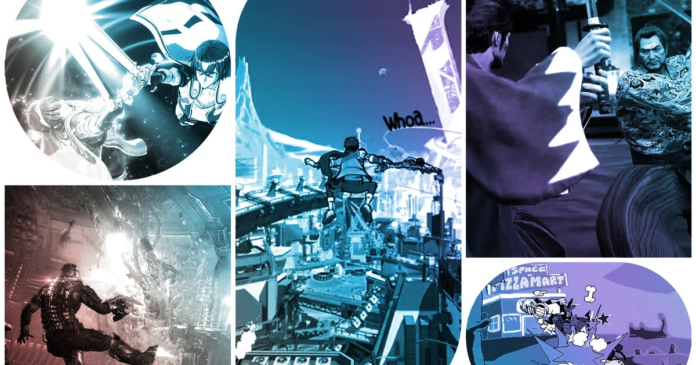Photo-Illustration: Vulture; Photos: Bethesda, EA, Nintendo, Sega, Tour De Pizza
The first few months of 2023 have been surprisingly flush with exciting video games. Yes, the megatons are off in the distance, we won’t be playing the highly anticipated The Legend of Zelda: Tears of the Kingdom until May, and the newest universe from Bethesda, Starfield, is currently earmarked for a September street date (if it doesn’t get delayed again). But in the meantime, we’ve had offbeat indies, consecrated remasters, and long-gestating sequels to keep us occupied. If you take our recommendations to heart, you’ll soon be orchestrating World War II battlefronts, gallivanting around industrial Japan, and enjoying the eldritch thrills of the one and only Pizza Tower. That, my friends, is a great way to start the season.
The following titles are listed by release date with the newest games up top.
Bayonetta Origins: Cereza and the Lost Demon (Nintendo Switch)
Photo: Nintendo
Bayonetta is an eight-foot-tall librarian who is capable of summoning flesh-eating monsters out of her waxy, jet-black hair. But even Amazonians have humble roots, and in Bayonetta Origins, we learn about how a young Cereza grew into the woman we know and love today. This new Switch title ditches the flashy combo-laden excess of the mainline games and approaches something much closer to an isometric Legend of Zelda diorama. Cereza, the future Bayonetta who wields a tome full of spells and fits the mold of a sullen, witchy teen, is controlled with one analog stick. The other one lets us pilot Cheshire — a rag-doll cat possessed by a demon — who handles most of the grunt work. You’ll be using both of their skill sets to crack puzzles and, yes, crush a whole lot of interdimensional assailants. That makes Bayonetta Origins slow, methodical, and thoughtful. Who says Cereza doesn’t have range?
Horizon Call of the Mountain (PlayStation 5)
Photo: PlayStation
The VR revolution — boosted by Facebook, Google, and practically every other spurious power broker in the tech sector — never totally broke into the mainstream. Still, Sony released its latest VR headset, the PlayStation VR2, earlier this year, and it’s an impressive piece of tech that is buoyed by an arresting slate of software. The Horizon series takes place in a high-concept postapocalypse during which humanity has regressed to the Stone Age and hulking cyborg dinosaurs stalk the blooming plains of the former United States. It’s the sort of world you want to see for yourself, and Call of the Mountain gives players that opportunity. You’ll be grasping at the rocky outcroppings of a granite peak with your calloused palms and threading rudimentary bows with your fingers, all while enjoying a condensed batch of cameos from some of the franchise’s famous faces. VR remains basically rudderless in its proof-of-concept phase, but Call of the Mountain could convince anyone of its potential.
Like a Dragon: Ishin! (PlayStation 5, PlayStation 4, Xbox One, Microsoft Windows, Xbox Series X and Series S)
Photo: Sega
Yakuza, the gargantuan Japanese media brand that the Like a Dragon imprint belongs to, has been supremely popular in its native country for decades without ever gaining much traction within English-speaking regions. But that dichotomy has started to erode over the past five years as more Americans began to fall in love with the franchise’s cockeyed humor and genuinely stirring storytelling. Case in point: Like a Dragon: Ishin! was originally released in Japan back in 2014, and it’s just now earning a westernized localization for a newly minted legion of Yakuza fans. Ishin! takes place in the 19th century, toward the end of the country’s shogunate era, and it’s a gratuitous spaghetti-western pastiche. Everything you’ve come to love about Yakuza, from the heavy soliloquies interrogating the nature of revenge and loyalty to the weirdly fleshed-out mini-games about chicken racing, are right in place. We now live in a world where a new Yakuza game is an industry-stalling event. Sometimes justice prevails.
Octopath Traveler II (Nintendo Switch, PlayStation 5, PlayStation 4, Microsoft Windows)
Photo: Square Enix
The first Octopath Traveler was well regarded for its magically ethereal art style: the way the game seemed to glow from within as the landscapes of the papered world layered on top of one another into the distance. But critics were less impressed with its rote combat and dreary storytelling, which means the sequel had a lot of work to do. Square Enix delivered in spades. The eight-pronged narrative is much more substantial compared to its predecessor, as it carefully augments the standard fantasy RPG notes. (You’ll wrest control of either a dancer who perfects her art in the memory of her long-lost mother or an exiled prince who is attempting to get the band back together.) These characters intersect a world that reverberates with its own lineage, customs, and faith. Octopath Traveler is, at last, a place to inhabit rather than to look at.
Metroid Prime Remastered (Nintendo Switch)
Photo: Nintendo
The Metroid formula was well established by 2002. The two-dimensional games, released in the ’80s and ’90s, starred Samus Aran — an intergalactic bounty hunter with a knack for unwittingly unleashing a universe-destabilizing contagion — as she slowly excavated a gigantic, interconnected, Easter-egg-laden map. Retro Studios was given the unenviable task of bringing a Metroid adventure to the GameCube, through which we’d look through Aran’s eyes in a first-person 3-D environment, and they passed with flying colors. Today, Metroid Prime is remembered as a moody classic and perhaps the greatest articulation of the constricting isolation so crucial to Metroid’s identity. Last month, Nintendo released an HD remaster of the game on Switch, so we can all celebrate its majesty and ache for a sequel that never seems to come.
Dead Space (PlayStation 5, Xbox Series X and Series S, Microsoft Windows)
Photo: EA
Dead Space arrived back in the mists of time, when a megapublisher like EA would green-light a linear, single-player survival-horror dirge with no meta-progression grind or DLC packages to lengthen its life span. Unsurprisingly, the Dead Space franchise has been dormant since 2013, until this resurrection. The 2023 incarnation of Dead Space is a down-to-the-studs remake of the original game, spruced up with fresh textures and animations, ensuring that the wriggling, glistening parasites of this cursed, derelict space station can evoke white-knuckle panic in zoomers and millennials alike. Enjoy the carnage, the gore, and the expertly paced, filler-free narrative. They don’t make ’em like this anymore.
Pizza Tower (Microsoft Windows)
Photo: Tour De Pizza
The best indie designers tend to extrapolate upon a video game they themselves sunk zillions of hours into during their youth. For Pizza Tower, the nerve center is the Wario Land series, which dominated a whole lot of Game Boy Colors in the mid-1990s. Those games swapped out the agile platforming of the mother Super Mario Bros. franchise for a ground-bound left-to-right plod; Wario doesn’t jump over the obstacles in his path — he lowers his shoulder and smashes through. Pizza Tower replaces Wario with a madcap pizza chef lost in a garish, hand-scrawled, Ren & Stimpy–esque universe. That textbook Wario Land sense of momentum is much more impactful with our modern processing power compared to what the Game Boy was capable of on its tiny eight-bit CPU, and the development team — Tour De Pizza — mustered a remarkable amount of polish for what is a fairly twee project. Personally, I can’t wait until they take on Wario World.
Hi-Fi Rush (Xbox Series X and Series S, Microsoft Windows, Xbox Cloud Gaming)
Photo: Bethesda Softworks
Hi-Fi Rush snuck up on us like a Beyoncé album: The game was announced, and released, on the exact same day. Tango Gameworks is best known for the downcast psychological torment of The Evil Within and Ghostwire: Tokyo, but here it has pivoted to an Über-colorful Devil May Cry action game with the cel-shaded fineline cartooning that immediately evokes the Dreamcast golden age. All of the combat is regimented to the beat of the soundtrack — a crunchy, Y2K-flecked pop-punk milieu — which adds a smidge of structure to the chaos. I know exactly when to end my combo; it’s whenever the bass drum hits.
Fire Emblem Engage (Nintendo Switch)
Photo: Nintendo
2019’s Fire Emblem: Three Houses revitalized the franchise by filtering this turn-based tactics game through the guise of a teen soap. You played a scholastic professor, who was inexplicably teenage, and nurtured a cast of lovable misfits through a martial education before they all succumbed to the cruelty of expansionary warfare. Engage throws outthose chatty digressions and returns to Fire Emblem’s roots. If Three Houses was about enjoying an introspective tea date with your friends, Engage is about moving troops around a map. For those of us who were thirsting for a Fire Emblem that gives us a tactical puzzle that neatly fits within a subway commute, Nintendo has finally heard our call.





